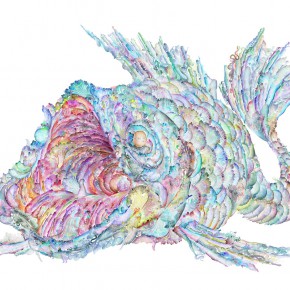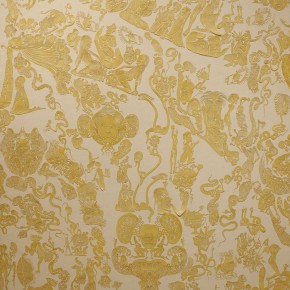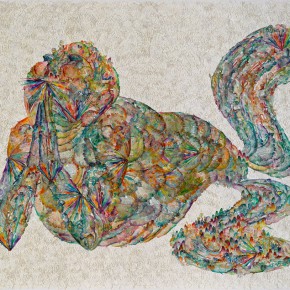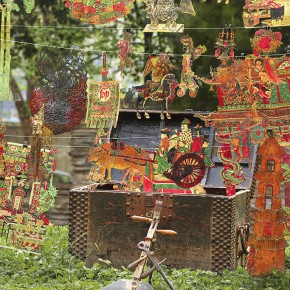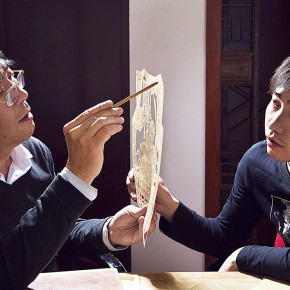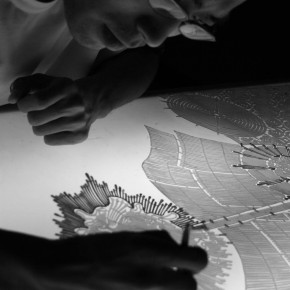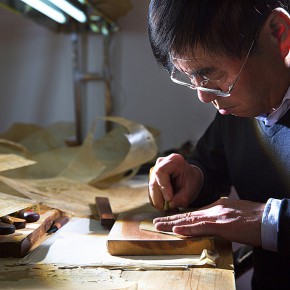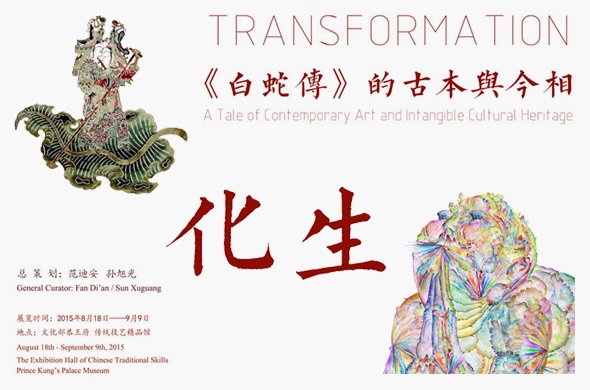
Directed by the Department of Intangible Cultural Heritage at the Ministry of Culture, jointly organized by the Management Center of Prince Kung’s Palace Museum and CAFA, “Transformation: A Tale of Contemporary Art and Intangible Cultural Heritage” is opening at Prince Kung’s Palace Museum on August 18, 2015, Fan Di’an, President of CAFA and Sun Xuguang, Director of the Management Center of Prince Kung’s Palace Museum serve as the general curators.
It is the first exhibition project hosted by the Management Center of Prince Kung’s Palace Museum in cooperation with CAFA, as the first thematic exhibition to research and practice the theme of “contemporary art involving in the intangible cultural heritage study” in the “Chinese Traditional Skills Exhibition” for the Chinese intangible cultural heritage productive protection series events, through a combination of display, play and research and mutual promotion to present the achievements and practice exploration, in order to deepen and promote the research, heritage and contemporary development of Chinese local cultures and traditional heritage, as an important achievement this exhibition of experimental art is held with cross-border collaboration with Prince Kung’s Palace Museum, it has a forward-looking and pioneering significance.
The exhibition is entitled “transformation”, aimed at through the presentation of more than 140 treasured shadow puppets of the Donglu Shadow Play in Shaanxi “The Tale of the White Snake” and the work of contemporary art “New Interpretation of the ‘Tale of the White Snake’” created by the young artist Wu Jian’an, to create a multiple correlation between the ancient version and present one of “The Tale of the White Snake”, to unfold a “hyperspace” dialogue between Chinese local cultural tradition and contemporary visual art; by shuffling texts and graphics, the documentary section reviews the changes and promotion influence of traditional productive skills, aesthetic style and mode of transmission of shadow puppets in the 10-year cooperation between Wu Jian’an, the state-level master of arts and crafts Wang Tianwen and his disciple, mutually refer to the works, on the one hand, it combs through the deep rooted relationship between contemporary Chinese art and traditional culture in the aspect of ideology, style and language, on the other hand, under the “transformation” of contemporary art creative thinking and aesthetic style, the ancient cultural heritage coruscate gives “l(fā)ife” in the new era, the contents of the three sections mutually echo each other, to build a multiple significance for the two dimensions of contemporary art and intangible cultural heritage protection.
In the “New Interpretation of the ‘Tale of the White Snake’”, Wu Jian’an used 7 paintings made up of 186 little images of various identities and names to form a large-scale work for the new interpretation and “mythic reengineering” of the classic story “The Tale of White Snake”, these images are shuttling and overlapping between each work, to constitute seven individual complete artistic images in the form of “homogeneous and heterogeneous”, to form a corresponding relationship with the inner structure of the classic text in the way of terms, to develop more possibilities for the reading of original plots and figures in the content, after widely dabbling in, deeply studying, summarizing and experiencing traditional culture, he started from the “conceptual” level to make a “transformation” of the local tradition; at the same time, he combined the shaping of line drawing and shadow puppets, allowing the traditional artistic style to intersect and integrate with the Western plastic language and contemporary artistic aesthetic form, to transform shadow puppets, the endangered folk tradition in contemporary society, to an important resource of visual creation, and it is an experiment of “transformation” starting from the “form-quality” level.
On the opening day, Duofu Xuan courtyard-the representative place of “Fu culture” of Prince Kung’s Palace Museum will launch a gathering for the exhibition opening and the first show of the Donglu Shadow Puppet in Shaanxi “The Tale of the White Snake” will be on display. During the exhibition period, there will be many performances of the shadow play, traditional skills will be shown, while academic seminars and other cultural educational events will be successively held, in order to hold the cultural activities while organically combining a lot of content, to promote a win-win co-existence of contemporary art and traditional skills.
About the Artist
Wu Jian’an was born in Beijing in 1980, and his ancestral home was in Jinshan, Shanghai. He graduated from Beijing Broadcasting Institute (now the Communication University of China), received a bachelor’s degree in 2002. He graduated from CAFA in 2005, with a masters degree, and started a teaching post after graduation. Currently he is an associate professor of CAFA.
In recent years, Wu Jian’an had participated in the “Live and Let Live: Creators of Tomorrow-the 4th Fukuoka Asian Art Triennale at Fukuoka Asian Art Museum, Japan in 2009, “Mind in Landscape-Contemporary Chinese Public Art Exhibition” at the John F. Kennedy Center for the Performing Arts, Washington DC, USA in 2011, “The Great Way Prevails-Contemporary Chinese Public Art Exhibition” in Kassel, Germany, in 2012, The Inaugural CAFAM Future Exhibition, CAFA Art Museum, Beijing in 2012, COSMOS: Opening Exhibition of Shanghai 21st Century Minsheng Art Museum, Shanghai 21st Century Minsheng Art Museum, Shanghai in 2014, “Carolyn Hsu and René Balcer Collection” at the Museum of Fine Arts, Boston, USA in 2015, etc., in addition, he held many solo exhibitions in Beijing, Shanghai, New York and so on, the works were collected by domestic and foreign art museums and foundations.
About the Inheritor
Wang Tianwen was born in 1950, one of the 5th Chinese Masters of Arts and Crafts, and the representative figure of Donglu Shadow Puppet in Shaanxi. In 1962 he became a close disciple of the famous artist of shadow puppet carving Li Zhanwen, to learn the technology of shadow puppet carving. He, along with Li Zhanwen designed and finished a large-scale shadow puppet screen “Princess Wencheng to Tibet” for the Shaanxi Hall in the Great Hall of the People in the 1980s, and he designed and carved a complete set of work of shadow puppet “Monkey Makes Havoc in Heaven” for the National Museum of Japanese History, which had been widely praised. In the 1990s, he sorted and identified thousands of collections from the Ming and Qing Dynasties for National Art Museum of China, Shanghai Museum and Shanghai Art Museum.
In the artistic career of more than 50 years, Wang has been committed to the research and development of Donglu Shadow Puppet in Shaanxi, skilled in traditional productive skills of shadow puppets such as leather, chasing, coloring, installing, and especially good at the use and innovation of the skill of pushing a knife in the leather to cut a puppet. In addition to the production of shadow puppets, he is skilled in sorting and replicating the ancient atlas, appraisal and repairing of the ancient shadow puppets, researching the historical origin, inheritance, rheology, characteristics, style, and even the profiles and customs, while he is the only one state-level master of arts and crafts for puppet carving skill in China.
Directed by Department of Intangible Cultural Heritage at the Ministry of Culture
Hosts: Management Center of Prince Kung’s Palace Museum, CAFA
Organizers: Organizing Committee for Chinese Intangible Cultural Heritage Productive Protection Series Activities, Research and Protection Center for Chinese Traditional Skills
Academic Supports: Graduate School of Chinese Academy of Social Sciences, Chinese Intangible Cultural Heritage and Traditional Skills Research and Teaching Steering Committee, International Heritage Society, Silk Road Arts, Art Research and Innovation Center at CAFA
In cooperation with China International Cultural Association, the editorial department of “Chinese Traditional Skills”, the School of Experimental Art, CAFA, Intangible Cultural Heritage Research Center in Shandong, Beautiful Asset Culture Industry Co., Ltd. In Beijing
General Curators: Fan Di’an and Sun Xuguang
Duration: August 18 – September 9, 2015 (closed on Mondays)
Opening: August 18, 2015 16:30
Venue: The Exhibition Hall of Chinese Traditional Skills Prince Kung’s Palace Museum
Courtesy of the artist, translated by Chen Peihua and edited by Sue/CAFA ART INFO


